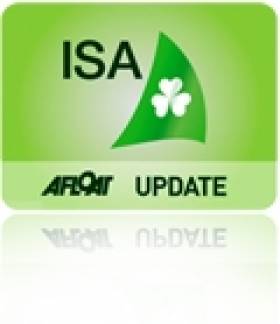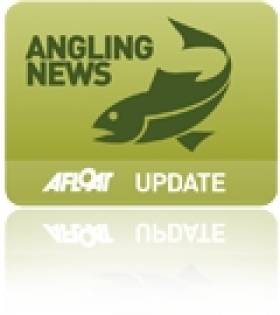Displaying items by tag: Media
#sailing – I have been friends for a long number of years with Ireland's two top international sailors who set new speed records for sailing in the Round Britain and Ireland Race. I hear regularly from them and am proud to be in touch with them and, as much as I could, have publicised the progress of their careers over the years I have known them. I believe that giving coverage to successful achievements by Irish sailors at international level is good for the country and for the sport.
Damian Foxall from Kerry and Justin Slattery from Cork deserve to be household names as much as icons in other sports. But, like many sailors, they are not in my view, being given the level of coverage they deserve in the general national electronic and print media.
The progress of the Olympic Providence IRL team at overseas events should also be given more coverage. This week John Twomey from Kinsale YC and his crew have been competing at the world disabled sailing championships in Canada in the hopes of qualifying for his 11th consecutive Games, but this has got little coverage nationally.
Hurling, the Irish women's rugby team, the emergence of potential new stars in Irish athletics, all deserve strong reportage but do Irish sailors not deserve coverage also?
The media at sailing events when there are problems – the GP14 Worlds in Strangford Lough this month; Dun Laoghaire in 2007 are examples of a degree of sensationalised coverage which lacked balance. They were reported as "near disasters," but lacked the qualification that the majority of the sailors looked after themselves, as they are expected in sailing to be able to do. If you go out in a boat, I was told from my first days in sailing, you take the responsibility of getting yourself back in safely.
Sailing deserves better coverage in the national media. Is it being denied that by either ignorance or bias against sailing, or the seemingly ever-present perception of the sport as elitist?
There are sailing journalists who attempt to counterbalance the generally negative attitude towards the sport, but as I found myself when working within RTE, it is an uphill battle and, in an island nation, this is not fair to the sport.
Justin Slattery from Cork is Bowman and a leading member of the Abu Dhabi Ocean Racing's Volvo Ocean 65, Azzam, skippered by Britain's Ian Walker, which crossed the finish line of the 2014 Sevenstar Round Britain and Ireland Race off the Royal Yacht Squadron in Cowes in an elapsed time of 4 days, 13 hours, 10 minutes, 28 seconds. This broke the previous world and race record for a monohull set by Volvo 70 Groupama, in 2010, by 1 day, 8 hours, 16 minutes and 27 seconds.
It was the second world speed record in sailing broken during the Round Britain and Ireland Race organised by the Royal Ocean Racing Club and another Irishman was also involved in the first.

Record breaking Damian Foxall and Oman MOD 70
Ireland's Damian Foxall added the Round Britain and Ireland Speed record time to his impressive offshore sailing CV on board the Oman Sail MOD 70 catamaran. The crew of Musandam-Oman Sail, a MOD70 Trimaran crossed the finish line of the race at with an elapsed time of 3 days, 3 hours, 32 minutes, 36 seconds. This broke the previous world record for a multihull held by Banque Populaire 5 in 2011, by 16 minutes, 38 seconds.
"We hit a new top speed for the boat of 43 knots right at the start," said Damian, Co-skipper on the boat. "The hard thing about a race record, as opposed to a course record, is that with a course record you can wait until the weather is perfect and you just go. In a racing format you don't have that option. The only time we tacked in an 1800-mile circular course was after we had gone through the finish line!""
The MOD70 was skippered by Sidney Gavignet from France, one of the top sailors in the world and who is heading next for the tough Atlantic race, the single-handed Route du Rhum.
It was not all plain sailing for Abu Dhabi's Azzam. Two crew members were hurt during the race. Justin Slattery injured his ribs while trimmer Phil Harmer injured his hand.
And let's not forget the National Yacht Club duo that, despite very heavy weather and suffering major gear failure have persevered in the Round Britain and Ireland Race. The story of their sporting commitment deserves national coverage. Liam Coyne raced two-handed with Brian Flahive on their First 36.7, Lula Belle and they showed a level of spirit and determination that would bring pride to any sport when they won the two handed division.
NEW HELVICK LIFEBOAT
Helvick is a lovely spot on the South-East Coast. A fine little harbour, dominated by fishing boats, with a few dedicated leisure sailors also. I am not too sure about the location of visitor moorings outside the harbour, but at many parts around the coast those could be located in better, more sheltered spots. But that is beside the point of why I am writing about Helvick which is because it has got a new lifeboat through a strong contact with an English family. It is an Atlantic 85, built at a cost of €255,000. It has a number of improvements from the Atlantic 75, Helvick Head's former lifeboat, including a faster top speed of 35 knots; radar; provision for a fourth crew member and more space for survivors. It can operate safely in daylight in up to force 7 conditions and at night up to force 6. It also allows lifeboat crews to respond even faster in emergencies.
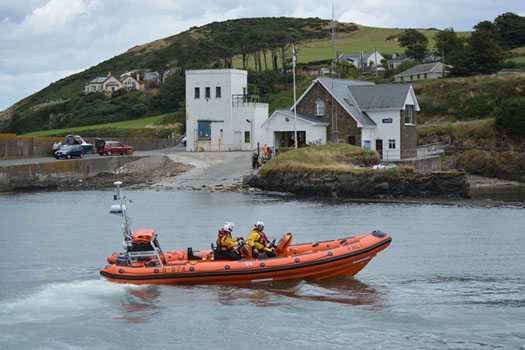
The new RNLB in Helvick and below the late Robert Armstrong after whom the new lifeboat, an Atlantic 85, is being launched in his name at Helvick Head lifeboat station
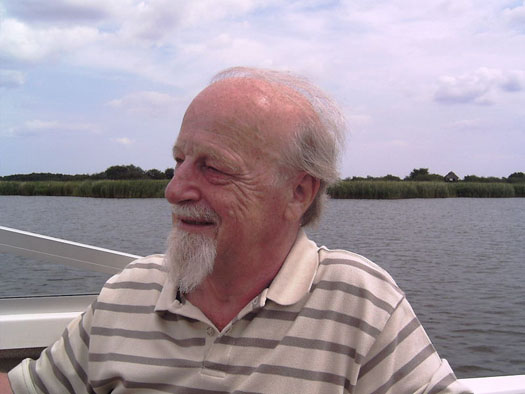
Its name is Robert Armstrong and it was funded by a legacy he left after his death in November of 2009. Born in 1936, he loved sailing, fishing and boats. His home was Blackheath but he had a holiday home in Potter Heigham on the Norfolk Broads, where he moored his own boat. There is a strong connection between the Armstrong family and Helvick. Robert Armstrong's aunt, Alice and her brother Charles, were the donors of Alice and Charles, Helvick Head RNLI's previous lifeboat and Robert had attended the naming ceremony there back in 2000 when he was given an RNLI jacket which he wore proudly.
CROW HEAD'S CABLE CAR
Paul O'Shea has written to me about an event at Crow Head:
"Hi Tom, I would like to promote an event on Crow Head on September 6. Lehanmore Community Coop want to replicate the first ever Cable Car crossing from there to the adjoining island. It will be a joint effort between Kerry Mountain Rescue and Castletownbere Coastguard Unit with the help of Castletownbere RNLI. All funds raised will be donated to KMRT."
HONOUR FOR JOHN TWOMEY
The decision to introduce a "President's Cup" event to honour John Twomey is well-deserved and recognises the achievements of Irish sailors, about which I have written earlier in this week's blog. Sailability Ireland, in conjunction with the ISA, has launched 'The Presidents Cup,' a new championship to encourage sailors with disabilities to compete in the classes sailed at Paralympic and international level.
'The Presidents Cup' has been named in honour of 10-time Paralympian and current President of the International Disabled Sailing Association, John Twomey from Kinsale Yacht Club. A team of 10 sailors from each of the four Irish provinces will compete in four different classes; the Hansa 303, SKUD 18, Squib and Sonar for this prestigious prize. Kinsale Yacht Club has kindly agreed to host this inaugural event which will be held on September 6 and 7. In 2013 the Club hosted the IFDS Disabled World Sailing Championships to incredible success and this event will form part of that legacy. Six races will be sailed and the team that has the best results in the four classes will be crowned champions. The event is being sponsored by Kingspan. A number of places are still available for both sailors with disabilities and volunteers who would like to participate in the championship. For more information Email: [email protected].
Sailability Ireland and the ISA are hoping that the event will encourage more sailors along the path to international competition. Supporting the availability of the sport to those with disabilities delivers on the commitment to sailing being a "sport for all". I remember the first time I reported on a disabled sailing event and how one lady competitor put me in my place when I asked her did she find it difficult to sail and she rightly responded: "Out on the water in a boat I am every bit as good as you!"
LOVE LIGHT AT A GREAT HEIGHT!
The tours of Ballycotton Lighthouse which began this Summer from the East Cork fishing village to the offshore island lighthouse have proved very popular, but now they are becoming a location for the lovelorn to commit their future!
A couple from Plymouth, Devon, became the first in history to announce their engagement at the top of the Llighthouse. During the scheduled noonday tour last Wednesday, 23-year-old Ryan Johnson proposed to 21-year-old Rebecca Daly on the lighthouse balcony and she accepted. They have a 5-month-old daughter, Lyra and were visiting friends in Ballycotton.
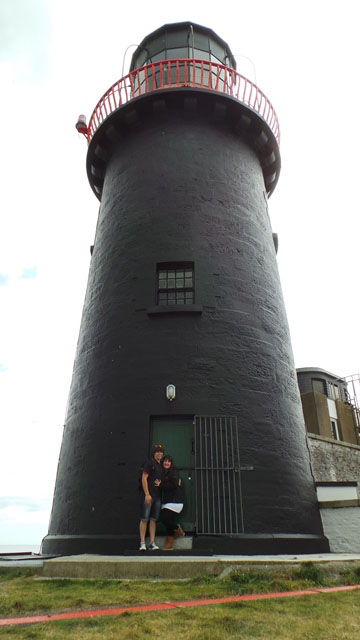
Happy couple back at ground level at Ballycotton lighthouse Ryan Johnson and Rebecca Daly on Ballycotton lighthouse
"Great to see romance is alive and well," said Derry Keogh, retired Ballycotton School Headmaster and local historian, who was the guide on their midday sailing trip to the island. "What a location to pop the question! When they heard about it, all the other tour visitors who were there gathered round and we sang 'Congratulations' - Phil Coulter maybe looking for royalties! This made it a double first for Ballycotton Island Lighthouse - the first ever sing song on the lookout tower!"
Since beginning in early July this year, the Ballycotton Island Lighthouse Tours have proved a great success with over 1,700 visitors hearing about the history of the lighthouse and seeing the view from the previously inaccessible lighthouse lantern balcony and island. This is an economic boost for the fishing village, both in profile and for local businesses.
VOLVO REPORTER
Irish sailing photographer and cameraman Brian Carlin has been appointed the Onboard Reporter with Team Vestas Wind for this year's Volvo Race. He has worked with the biggest names in the sailing world and on some of the biggest races.
Chris Nicholson, the four-time race veteran, who skippered Camper with Emirates Team New Zealand in the last edition of the race, will lead Team Vestas Wind, a campaign sponsored by Vestas, the Danish wind energy company. This is the seventh team in this year's Volvo round-the-world which begins with an In-Port Race on October 4 in Alicante, Spain.
SEAFOOD EFFICIENCY
And speaking about fishing and seafood which is increasing its attraction to consumers, retailers who sell fish are being urged to take part in a new scheme by Bord Iascaigh Mhara (BIM), the Irish Sea Fisheries Board, the State agency with responsibility for developing the sea fishing and aquaculture industries. This is the
"BIM Green Seafood Business Programme," aimed at assisting seafood businesses to reduce their environmental impact and save on energy costs. ""Making seafood processes more sustainable can improve a business 'bottom line' by reducing costs and enhancing their environmental reputation," says BIM.
In conjunction with Green Business and SEAI, BIM I are hosting a series of FREE, half-day seminars to assist Seafood Retailers. They will be held in Dublin on Tuesday, October 14 at the Radisson Blu Hotel, Dublin Airport; and in Cork on Thursday October 16, at the Park Inn, Cork International Airport. Advance booking is required as places are limited. For more information and to book, contact Lorraine O'Byrne in BIM on 01 2144185 or email [email protected]
Email: [email protected]
Twitter: @Tom MacSweeney, @AfloatMagazine
#ISA NEWS - The Irish Sailing Association's Olympic Department is inviting tenders for photographic services and social media content for the Irish sailing team at the Sail for Gold Regatta in Weymouth from 4-9 June.
The tender requires attendance at Sail for Gold from Wednesday 6 to Saturday 9 June inclusive.
The photography portion involves daily coverage of Irish sailors racing with a target of 6-10 images per sailor (schedule to be agreed with support team dependant on campaign performance and availability of media boats), plus headshots of the squad and support teams in team clothing, and group shots with and without support teams.
Social media content will involve daily pre-race audio and video with the performance director; daily audio/video with sailors from the media zone; and a micro documentary (3 minutes max) on pieces of interest from an Irish perspective.
Applications for this tender should be emailed to [email protected] by the closing date tomorrow, Friday 13 April 2012. A decision will be made before 20 April to allow time for accreditation and registration for media boats.
Full details on requirements and details of rights and pricing are available on the ISA website HERE.
Bumper Catch for Media at Annamoe
#ANGLING - Journalists were angling for a different kind of story at Annamoe Trout Fisheries recently as they competed for the Dublin Crystal Perpetual Trophy, The Irish Times reports.
The eighth annual event at the foothills of the Wicklow Mountains brought together 17 writers from across the Irish media landscape for a friendly test of their angling skills.
John Buckley of Total Flyfisher magazine, who was the first to strike gold at the end of the trout rainbow in last year's event, quickly zoomed ahead of the pack with a total of 21 catches.
And this year's first-timers - which included Brian Cooke of Irish Angler's Digest and celebrity chef Chris Sandford - also set impressive totals.
The Irish Times has more on the story HERE.
New Media Man Announced for Discover Ireland Backed VOR Entry
Team Sanya, the Chinese - Irish backed entry in the 2011/12 Volvo Ocean Race, announced today that Andres Soriano (ESP/USA) is to take on the role of their Media Crew Member.
There has been some disappointment at home given the only Irish crew member on board the boat was Frankie Leonard who withdrew over seasickness in late September. Subsequent applications for the media post included Irish sailors who it now appears were unsuccessful in their quest to join Mike Sanderson on the Sanya boat, 25% funded by Discover Ireland.
Andres started working with Team Sanya as part of the Shore Team back in August 2011 when the team was based in the UK. Since then he has developed a close fit with the team and has gained a detailed understanding of the team objectives as well as the workings of the race boat. These facts, combined with Andres' media background and
experience, puts him in a perfect position to take on this role and deliver great results for the team and the event.
Mike Sanderson, CEO/Skipper for Team Sanya, commented on today's announcement:
" Since day one, Andres has fitted in perfectly with our team spirit and personality. He is an incredibly hard worker and has turned his hand to anything we have thrown at him, which has won him enormous respect from the guys. He has the right balance of media skills and creativity coupled with offshore sailing experience and so I have high hopes for his ability to tell the Team Sanya story to the outside world in a dynamic and unique manner." Andres Soriano, new Media Crew Member for Team Sanya, gave his reaction
to his new role:
"I am truly ecstatic and excited about my role as media crew member. I know it will be one hell of a ride and I consider myself very lucky to be a part of this awesome Team Sanya race crew. We have already built up a keen fan base and I will definitely take on the challenge to expand that by telling our story in an insightful way never seen before."
Andres Soriano Biography details:
Date of Birth : March 26th 1986
Nationality : Spanish American
Resident : Manila, Philippines/New York, USA



























